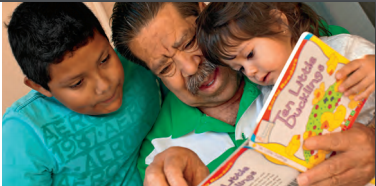5 Factors Impacting 3rd Grade Reading
 Children who aren’t reading at grade level by the end of 3rd grade are four (4) times as likely to drop out of high school, significantly reducing their chances to succeed in work and in life. [1]
The Annie E. Casey Foundation has published two recent reports underscoring the importance of focusing on 3rd grade literacy as a pathway to learning and life success – and as an essential step toward breaking the cycle of intergenerational poverty.
Children who aren’t reading at grade level by the end of 3rd grade are four (4) times as likely to drop out of high school, significantly reducing their chances to succeed in work and in life. [1]
The Annie E. Casey Foundation has published two recent reports underscoring the importance of focusing on 3rd grade literacy as a pathway to learning and life success – and as an essential step toward breaking the cycle of intergenerational poverty.
Key Stats: 3rd Grade Literacy
Early-grade reading proficiency in the U.S. is especially challenging for students from low-income families. The Foundation’s 2013 report highlighted statistics including:
- 83% of 4th graders from low-income families failed to reach the “proficient” level in reading.[2]
- People who fail to complete high school by age 20 are 50% more likely to have sporadic employment and 7 times more likely to be persistently poor as young adults.
- Only 2% of those who finish high school, work full time, and marry before having children end up in poverty compared to 75% for those who have done none of these things.
If we can improve 3rd grade reading proficiency – especially for our most at-risk children – we can help provide a critical foundation that encourages academic success, on-time high school graduation, and the opportunity to create a fulfilling and productive life.
5 Areas That Impact 3rd Grade Reading
The Foundation’s first report, “Early Warning! Why Reading by the End of Third Grade Matters,” helped launch the national Campaign for Grade-Level Reading (GLR). As a result, 124 communities in 34 states (representing 350 districts and 8 million students) committed to actions recommended by the GLR – encompassing 16% of all U.S. children attending public schools.[3]
So what are the actions that have been proven to help move the needle on 3rd grade reading proficiency?
The Foundation’s most recent research report, “Early Warning Confirmed: A Research Update on Third-Grade Reading,” notes five key action areas:
- Increasing School Readiness. The definition of kindergarten readiness in this report encompasses multiple measures, including a) health, b) language development, 3) social-emotional skills and 4) participation in high-quality early care and learning programs. Preschool attendance ranked as one of the strongest success factors influencing the school readiness of children from low-income families.[4]
- Reducing Chronic Absence. Students who are chronically absent score lower on reading tests than other students. Those students who arrive at school ready to learn but then miss 10% of kindergarten and first grade have been shown to score 60 points below regularly attending students on third-grade reading tests.[5]
- Preventing Summer Slide. Many low-income children fall behind during the summer by as much as two months of reading achievement, while their middle-income peers make slight gains. Quality summer programs (including volunteer reading programs), as well as providing access to books for economically disadvantaged children, can counteract this trend.[6]
- Counteracting Family Stressors. Family stressors – including hunger, housing insecurity, family mobility, family violence, parental depression, and abuse and neglect – can hinder a child’s ability to learn. Creating positive social-emotional experiences, and building supportive family and community environments can reduce the long-term effects of this stress in young children and restore their readiness to learn.
- Elevating Teacher Quality. High-quality teaching and learning environments can positively impact children’s language and literacy skills. These high-quality experiences include not just teachers at school, but also family members at home, and caregivers in community settings. Helping parents create consistently supportive learning experiences in the early years can help close the school readiness gap for children from low-income backgrounds.[7]
Reading proficiency by the end of 3rd grade is a strong indicator of future school and life success. It continues to be a growing focus area for many communities who are collectively advocating for a brighter future for their most at-risk children and families. We are proud to be a part of Fort Worth’s commitment to building a strong foundation that will enable all of our children to succeed.
To learn more about quality early education and literacy efforts underway in Fort Worth, or to find out how to get involved, visit:
- Raising of Fort Worth: www.raisingoffortworth.com
- Early Learning Alliance: www.earlylearningntx.org
- Fort Worth Literacy Partnership: www.readfortworth.org
[1] “Double Jeopardy: How Third-Grade Reading Skills and Poverty Influence High School Graduation,” by Donald J. Hernandez and supported by Annie E. Casey Foundation, 2011.
[2] On the National Assessment of Educational Progress (NAEP)
[3] In 2012
[4] According to Brookings’ analysis of ECLS-B data
[5] On average according to a study of 640 students in 19 California school districts. Balfanz, R., & Byrnes, V. (2012). The importance of being in school: A report on absenteeism in the nation’s public schools. Baltimore: Johns Hopkins University Center for Social Organization of Schools.
[6] Allington, R.L., McGill-Frazen, A., Camilli, G., Williams, L., Graff, J., Zeig, J., Zmach, C., & Nowak, R. (2010). Addressing summer reading setback among economically disadvantaged elementary students. Reading Psychology, 31(5), 411–417
[7] Learning from mom boosts low-income kids’ school readiness. (2011, June 20). Science Daily. Retrieved from www.sciencedaily.com/ releases/2011/06/110620112108.htm, citing Rodriguez, E.T., & Tamis-LeMonda, C.S. (2011). Trajectories of the home learning environment across the first 5 years: Associations with children’s vocabulary and literacy skills at prekindergarten. Child Development, 82(4), 1058–1075.
